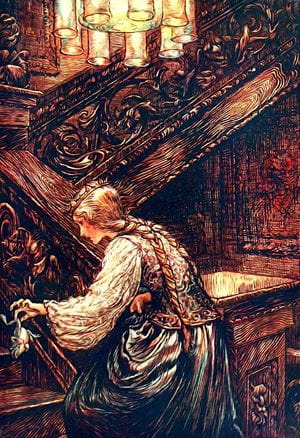
Pixabay.com
While many more hard line Christians, like those who reject Rowling’s novels, would also consider fairy tales to be “occult,” there are more mainstream Christians who have raised the question as well. Many fairy tales, after all, involve deals with the devil, sex and gruesome punishments visited on the wicked. How can those have any place in a Christian household?
Strong Moral Tales
Most fairy tales have a strong moral theme that is extremely compatible with Christianity. There are dozens of stories, after all, that emphasize virtues such as selflessness, humility, kindness, loyalty and generosity. A reoccurring theme in fairy tales is a protagonist who has little of their own but still helps a stranger. This generosity turns out to help the hero or heroine later in the story. Another common theme is loyalty or faithfulness. One of the most common plotlines is a young woman who is married to an ugly or cursed man. She remains faithful to him, however, and in doing so breaks the curse. Most protagonists live what would be considered good Christian lives, and the excitement of their stories drives morals home much better than any parental lecture. Children are much more interested in living like their heroes than listening to mom and dad tell them what to do.Centrality to Culture
Most people do not notice it, but fairy tales are everywhere in culture. People often reference them without noticing, and many modern movies, film and TV shows assume a familiarity with fairy tales. “A real-life Cinderella story” has become linguistic shorthand for rags-to-riches tales, and the reference is so widely understood that the phrase “Cinderella story” has appeared repeatedly in news outlets. Cutting children off completely from fairy tales will leave them struggling to understand why one of their peers is nicknamed “Rapunzel” or why some children cringe at the idea of a divorced father remarrying. Such gaps in a child’s cultural education will leave them easy targets for bullies and lead to condescending pity and contempt later in life.Encourage Creativity
Fairy tales are some of the first tales that children continue to think about long after the story is finished. The mystical worlds are fascinating, and few fairy tales give more than a basic description of the characters. “Young woman with long, shining hair” and “evil witch with a crooked nose” is about as much detail as fairy tales provide. This leaves children the ability to really imagine the characters’ appearances. Such moments train children to be able to visualize the characters and events of chapter books later.Fairy tales also teach children to use their imaginations. There are entire worlds to imagine in fairy tales, and many children enjoy thinking about what happened after “happily ever after.” Did the prince and princess have two children? Were they boys or girls? What did the wedding look like? What happened to the fairy godmother? Did she come to the wedding or go help another poor girl? It is through such questions that creativity is born.
Love of Reading
If children never encounter short stories they enjoy, they are never going to want to pick up longer books later. Reading will become an unpleasant chore, something they are forced to do. Fairy tales, however, give children stories that they enjoy reading and want to come back to over and over again. This love of early stories carries over into a general enjoyment of literature. Furthermore, a child who grows up with fairy tales is more likely to be able to understand the longer books they read in school. Classic literature, after all, is littered with references to fairy tales, and many books assume at least a passing familiarity with many old folktales.Comfort
Beyond the comfort that a child finds in having their parents read to them, the simplistic and moralistic nature of fairy tales gives children a comfort that extends far beyond their childhood. Fairy tales are where children see, in stark black and white, that good triumphs over evil. Most other stories, even Biblical stories, feature flawed heroes, pyrrhic victories and bittersweet endings. With fairy tales, however, the lines between villain and hero or good and evil are stark. Many well meaning adults think that these simplistic lines fail to prepare children for the shades of grey out in the “real world.” In reality, those more three dimensional characters adults favor tell children that there is no pure good and evil and that there are no really happy endings. Fairy tales, meanwhile, tell children that good can triumph over the evils children are already encountering in bullies at school. As the devout Christian C.S. Lewis said, “Since it is so likely that children will meet cruel enemies, let them at least have heard of brave knights and heroic courage.”Fairy tales have remained entrenched in cultures all around the world for a reason. Children that grow up without fairy tales may find themselves struggling to relate to their peers. They will be missing essential context for their friend’s conversations and may find themselves ostracized. Clearly, fairy tales have a lot to offer to young children, but there are still Christian parents who will be wary of these tales. That said, there are plenty of ways to get around the unpleasantries that linger in these old stories.
Violence and Sex
The original fairy tales fell out of favor for a reason. These old folktales were drenched in blood, sex and violence. Anyone who has ever read the original “Rapunzel” or “Sleeping Beauty” has been unable to look at Disney movies the same way again. That said, cleaner versions of the old fairy tales exist. Until recently, many people were unaware that these gentle stories did not always end with “happily ever after.” Christian parents who are concerned about violence need only stick to more modern variations of the old folktales to avoid the bloody punishments often inflicted on wrongdoers in the original versions.Magic, Fairies and the Occult
Most fairy tales involve breaking curses and dealing with evil witches. The presence of magic is a staple in the genre, and the idea of willingly exposing impressionable five year olds to stories about magic makes some Christian parents break out in hives.Rather than panicking over the idea of their children learning about magic, parents need to take a deep breath and accept that children are eventually going to be exposed to the idea of the supernatural. Children have an incredible capacity for imagination, and most children are fantasizing about magic long before they know how to say the word. Where else do the monsters under their beds come from? Trying to keep children from ever encountering more common ideals about magic is a battle parents are fighting in vain. Instead, parents who believe in the dangerous elements of the supernatural can use fairy tales to shape their children’s ideas about magic itself. Parents can choose fairy tales where magic is malevolent and used for evil to drive home the dangers of the supernatural. They can also pick from the numerous cautionary fairy tales that detail the dangers of making deals with supernatural entities.
Parents who do not want their children to believe in magic have a much simpler task. These parents need only explain to their children that fairy tales are not real. Little men and women do not actually live under toadstool caps or in the hollows of trees. It is likely a nonissue anyway. Despite their vivid fantasies, most children are acutely aware of what is real and what is imagined.
There is also a third choice for wary parents: choose fairy tales that center around Christian protagonists. “East of the Sun and West of the Moon,” “Herr Mannelig” and “The Bells of Forrabury Church” all feature Christians as the main characters. There are also multiple stories of Christians whose faith protected them from the wickedness of fairies and elves such as “The Smith and the Fairies.”
Fairy tales are much more than just old stories that some parents read their children. They form a cultural backbone of literature, art and film and carry many worthwhile lessons. Most complaints about fairy tales apply only to the original stories, and those were products of their much harsher time. Today, there are many ways to avoid the unpleasant elements that lurk in old fairy tales while still letting children delight in these age old tales. Exposing children to such stories will help them fit in with their peers and give them comfort if they do not. For the misfits, fairy tales are a reminder that good will triumph over evil, and kindness will win out over cruelty. As G.K. Chesterton said, “Fairy tales do not tell children that dragons exist. Children already know that dragons exist. Fairy tales tell children that dragons can be killed.”

